Quick Guide to Czech Bead Shapes – Two Hole Beads
Two hole beads have come a long way since I bought my first tube of SuperDuo beads. Now when it comes to “playtime”, we have all kinds of options. You can use them by themselves, or along with your favorite seed or other beads. Want even more fun? Mix different sizes and shapes!
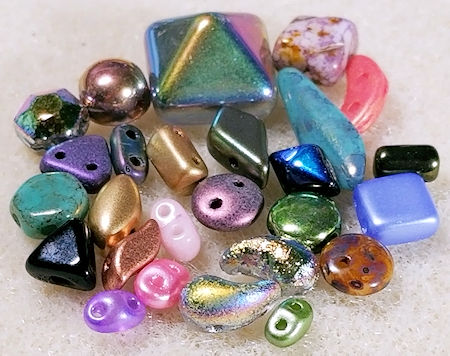
Just a Few Two Hole Czech Beads
When shopping for these beads, you’ll typically see them as “Czech seed beads” or “Czech beads” or “CzechMates”.  Supposedly the sizes of the CzechMates are more standardized, so they work well together — they used to be just 6mm on the longest side. However, there are other sizes in the CzechMate family now, so the lines are getting blurred.
I was originally making this one large post, but then I realized how very long it was! So, I am splitting this into three posts — two holes, one hole and three of more holes. (I’ll link them as soon as I have the other posts up.)
This post will be about the various two-hole shapes that are out there, with their sizes. I’ll list them in alphabetic order.
- Amos par Puca: These are pear-shaped beads, with the two holes running through the sides. 5mm x 8mm.
- Arcos par Puca: Three holes, these are crescent-shaped, with the holes running along the side of the bead. Size is 5mm x 10mm.
- Bar: Two holes, these are typically used as a spacer. The beads resemble a flattened oval, with the holes running horizontally. Size is 2mm x 6mm.
- Baroque Cabochon: Two holes. This is a cabochon shape, but the curved top has a baroque pearl kine of look. The two holes are parallel through the bottom. 7mm diameter at the bottom.
- Bi-Bo: These are similar to SuperDuo beads, but the centers are concave instead of convex. Approximately 5.5mm x 3mm in size.
- Brick: Similar to Bar beads, but these are more rectangular. The size is 3mm x 5mm.
- Cabochon: Two holes. These beads have flat backs and a domed top. They kind of remind me of gumdrops! 4.5mm x 6mm. I’ve also seen them in a 7mm diameter.
- Carrier: Two holes. New to the market (at the time of this writing), they are much larger than the standard two-hole beads. They are more pillow-shaped — thinner on the ends, thicker across the middle. Intriguing, as I’ve yet to buy and try them. They are 9mm x 17mm.
- Crescent: Two holes. Similar to Arcos par Puca, but the holes are on the face of the bead, instead of through the side. 2mm x 10mm in size.
- Dagger: Two holes or one hole, these are very much like regular dagger beads. 5mm x 16mm.
- DiamondDuo: Two hole beads, these are diamond-shaped. One side is flat, and the other is lightly faceted.  5mm x 8mm.
- DiscDuo: Two holes. These are flat lentil-ish, bit with the holes through the narrower side of the bead. Approximately 4mm x 6mm.
- GemDuo: Very much like the DiamondDuo, but the side that isn’t flat has more of a rounded profile, as opposed to faceted. Approximately 8mm x 5mm.
- Half Moon: Similar to the Crescent beads, but instead of having a curve on both sides, the curve is on one side, while the other is flat. They are also a bit smaller in size. The holes are on the face of the bead. 4mm x 8mm.
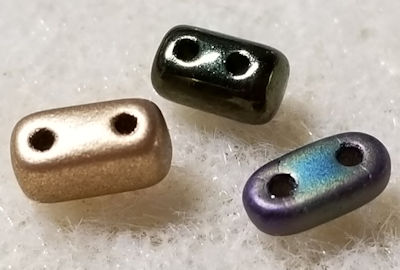
Bar, Brick and Rulla
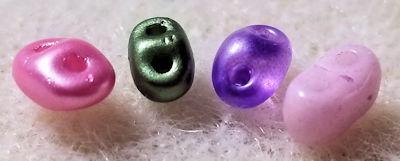
SuperDuo, MiniDuo, Twin and Bi-Bo
- HoneyComb: These beads have the two holes runningthrough the narrower side of the bead. Both the top and bottom are flat. And of course, they are six-sided and look like a honeycomb! 3mm x 6mm.
- HoneyComb Jewel: The same as the regular two-hole HoneyComb, but these are faceted on one side. Roughly 4mm x 6mm in size (the facets make it a little bit thicker).
- Ios par Puca: Very similar to the Bar beads, they also have a rounded top and bottom, but with straight sides. Size is 2.5mm x 5.5mm.
- IrisDuo: Two holes. These are a smooth marquise in shape, and the holes are parallel through the sides. 4mm x 7mm.
- Kite: Two holes. Similar to the DiamondDuo, but these have more of a kite shape than a diamond shape. 5mm x 9mm.
- Kheops par Puca: Interesting triangle bead. Two holes, which run vertically from base to tip. Both top and bottom are flat. Size is 3mm x 6mm.
- Lentil: Two holes. These have a puffed disc shape, and the holes are on the flatter sides. Size is 3mm x 6mm.
- MiniDuo: Two holes, these are like SuperDuos, just a little smaller. Same shape, but the size is 2mm x 4mm.
- Nib-Bit: Two holes. These remind me of flattened gumdrops on steroids, LOL. Think of them as a very tall cabochon, but instead of the holes being at the bottom of the bead, they are parallel through the sides. 5mm x 6mm.
- PaisleyDuo: These are paisley-shaped as you might imagine. The top and bottom are flat, and the holes run parallel though the sides. Because the top and bottom are flat, they can be used as both right facing and left-facing (i.e., which direction the tail points). 5mm x 8mm.
- Piggy: Lentil beads, but instead of the holes being even spaced on either side, one is in the center and the other is off to the side. They are also slightly larger, with a size of 4mm x 8mm.
- Pyramid: Think of these as a pyramid, except instead of having only 6 facets, these have 6 facets. The holes are parallel through the bottom. 12mm.
- RounDuo: Two holes with a slightly off-round shape (which you may not really notice unless you put them next to some really round beads, like glass pearls). Size is 5mm.
- Rulla: Two holes, these are like Bar beads, but rounded on the front and back. The sides that have the holes (which run horizontally) are flattened. Size is 3mm x 5mm.
- Silky: These are two hole tile-shaped beads, flat on one side and with a “puff” on the other. The holes on this bead run diagonally. 4mm x 6mm.
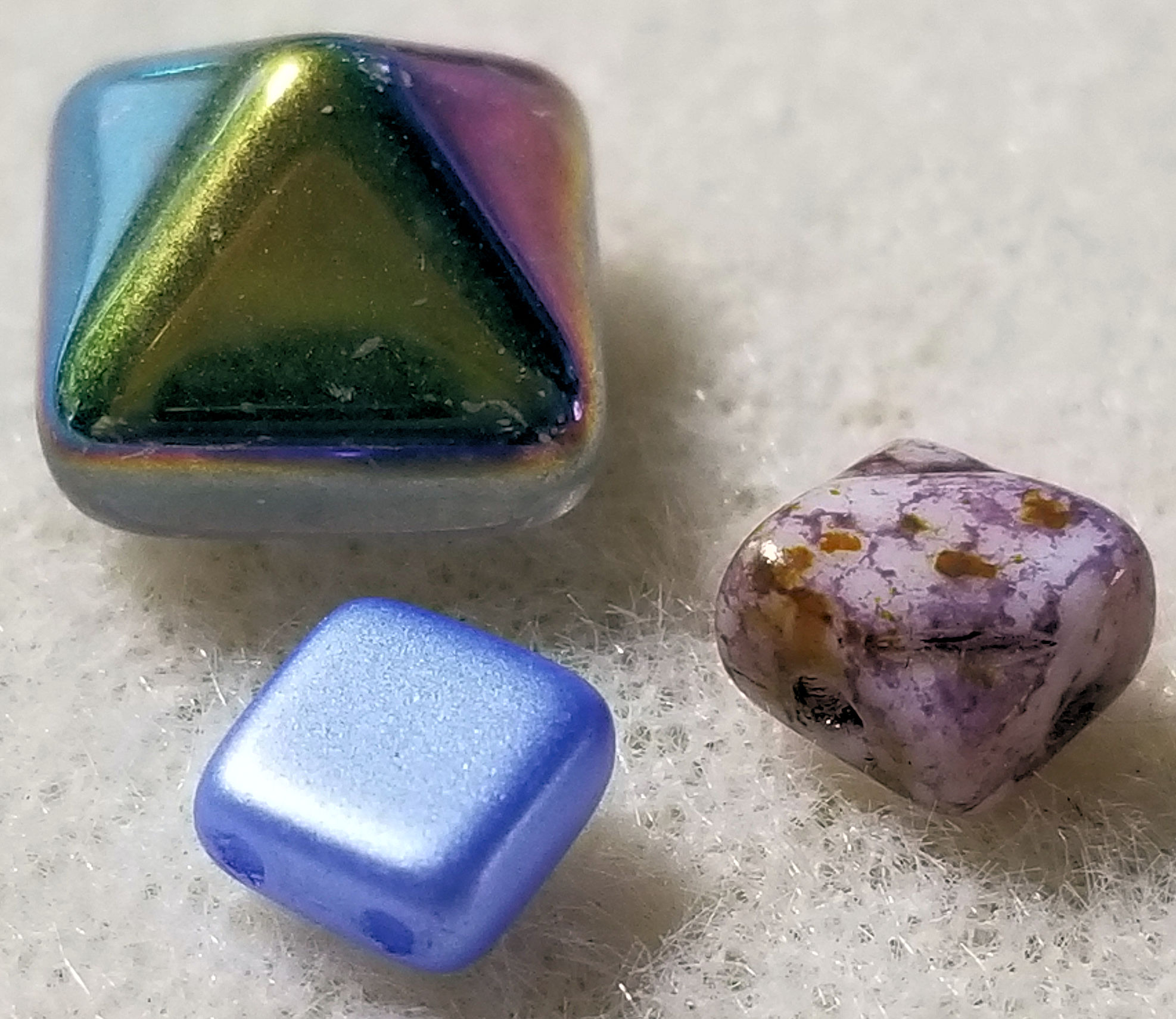
Stud (Pyramid), Silky and Tile
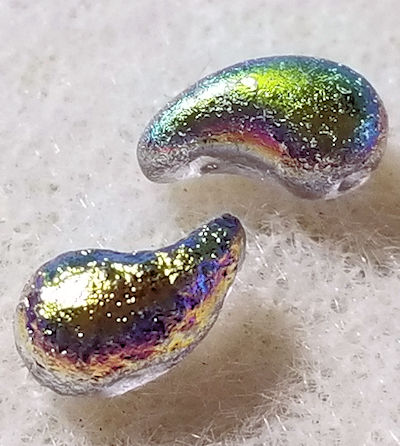
ZoliDuo Beads, Left and Right
- Stud: Two holes, with one flat side and the other with four facets, meeting up to a gently rounded point. I’ve seen these in both 6mm and 8.5mm x 12mm sizes, but the 12mm size is most common.
- SuperDuo: Two-holes, these are probably the best known and most popular of the two hole beads. Somewhat of a tapered oval, gently rounded with a slight “pinch” in the center. 2mm x 5mm.
- Super Kheops par Puca: These are the regular Kheops par Puca, but closer to a pyramid-type bead. 6mm.
- Tile: These are flat square beads, with the two holes running horizontally. Size is 3mm x 6mm.
- Triangle: Two holes. These are flat, thin beads, with the holes at the bottom.  2mm x 6mm.
- Twin: Two holes. Very much like the SuperDuo, but a little more rounded and every so slightly thicker. 2.5mm x 5mm. It’s easy to mistake these for SuperDuos.
- ZoliDuos: These are paisley-shaped, like the PaisleyDuos. The difference is that the ZoliDuos have one side that’s flat and one that is rounded.  In any case, because both sides are’t flat, they come in both a right side and a left side — there is definitely a difference in the way the tail points, so when you buy these, make sure to get both left and right versions. 5mm x 8mm.
These are the ones that either I have, or at least have seen at the time of this writing. There are even more out there, because new ones seem to pop up each day. And I have undoubtedly missed some on this list!
Interested in how to use these beads in projects? Check out my Youtube playlist for two-hole beads!
Seed Beads Reload – Video of Sizes and Colors
I’ve had a post previously about seed bead sizes and colors. This is an update, because seed beads are a moving target! In this post, we’ll talk a little more about seed beads, and a little further down, I have a video so you can perhaps better get an idea of some of the sizes and colors that are available.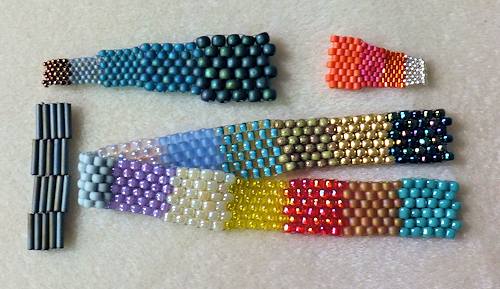
I’ll also talk about the shapes of seed beads — traditional, cylinder, charlotte and bugle. (I’ll do a separate post on all the other neat shapes available these days.)
Seed Bead Shapes
First, you need to know shapes. Why you may ask? Glad you asked, because not all seed bead shapes are good for all bead weaving stitches. Let me rephrase that — some shapes are better than others for certain beading stitches. Each shape has their pros and cons, so let’s get started.
Traditional Round
These are your doughnut shaped beads. There are two main origins for these beads — Japan and the Czech Republic. In general, the Japanese beads are a bit more consistent in shape and hole size. They also come in far more colors. The Czech beads come in fewer colors and are more irrecgular. However, this is changing, because I am seeing some gorgeous multi-colored beads coming out of the Czech Republic.
Whenever you see “seed beads” in a supply list, unless specified differently, it generally means the traditional rounds.
The traditional round beads are good with any beading stitch. Keep in mind the variations of the individual beads — depending on your project, you may need to sort through your beads and take out the ones that are noticeably larger, smaller or more irregular.
Cylinder
These are usually known as “Delica” and are made by Miyuki in Japan. However, Toho (also Japan) makes a cylinder bead as well, called “Aiko”. They are both very regular in size and shape.
Cylinder beads are like teeny-tiny tubes. They also have a larger hole than do similarly-sized round beads. The cylinder beads are slightly smaller than the traditional round — a size 11 Delica or Aiko is more like a size 12 traditional round bead.
Best uses for cylinder beads are stitches like peyote, brick, ladder and square. They aren’t as good for herringbone or right angle weave.
Charlotte
The vast majority of the charlotte beads come from the Czech Republic, but Miyuki also makes some charlottes. This kind of seed bead is characterized by a single facet cut into one side of the bead. They are also typically irregular in shape…which makes them a great choice for organic looks!
Charlotte beads are typically very small — sizes 12, 13 and 15 – although I have rn across some size 8 charlottes. The holes are tiny in the beads coming out of the Czech Republic, and a slight bot larger in the Miyuki beads. Don’t expect to get all that many passes with a needle and thread through these seed beads.
You can use charlottes anywhere you use the traditional round beads, as long as you either use a very fine needle and thread, or use a stitch that doesn’t involve a lot of passes through the beads.
Bugle
Bugles have been around for quite awhile, and they have definitely evolved over time. These are cylinders to the max, so to speak — thin tube-shaped beads.
As for colors, don’t expect a huge range. You should find all the “usual colors”, but there are a lot of more specialized colors that aren’t available.
Bugles can be readily used in peyote, square, brick and ladder. Not so much the others, except for special effects.
Time for the Video
I’ve gone on quite a bit just on the different kinds of “regular” seed beads, so I won’t go into colors in this post. You’ll be able to see good examples in the video.
One kind of color finish I didn’t mention in the video is dyed. There are some absolutely gorgeous dyed colors in seed beads, but avoid them unless your piece will not be handled. And won’t get wet or sit in bright sunlight. Yes, the color wears off, and can bleed.
Although I say it in the video, it bears repeating — if you are buying galvanized beads, look for those marked as permanently galvanized (also sometimes called “permanent finish”). Don’t buy the regular ones –the beautiful metallic coating will rub off, probably the first time you wear your jewelry. Permanently galvanized beads hold up very well, though.
That’s it for now — stay tuned for the video on the myriad new shapes of seed beads — triangles, drops, cubes and the cool two-hole beads (to mention a few).